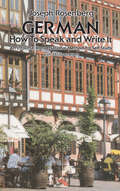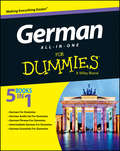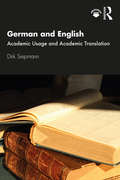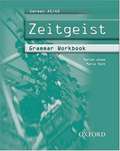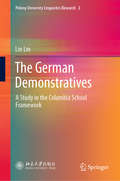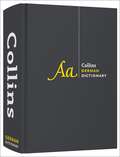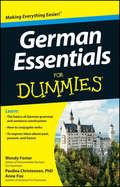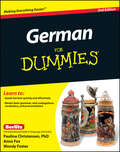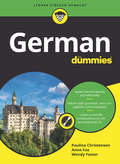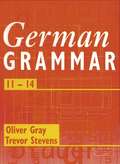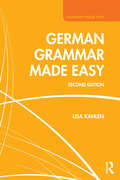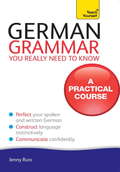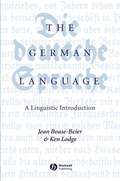- Table View
- List View
German: How to Speak and Write It
by Joseph RosenbergThis is probably the most delightful, useful, and comprehensive elementary book available for learning spoken and written German, with or without a teacher. Working on the principles that a person learns more quickly by example than by rule, the author has put together a book that abounds in immediately usable German sentences and phrases on a wide variety of subjects.The student will find pleasure in the amusing sketches and drawings used to imbed new vocabulary firmly in the student's mind, in the many excellent photographs of cities and landmarks in German-speaking countries, and in the glimpses of German culture and custom subtly interwoven into the conventional material.The book, though eminently useful for self-study, is especially amenable to classroom use or study with a private tutor. The variety of teaching aids that this book places at the teacher's disposal is remarkable. The lessons contain dialogues, grammar and idiom studies (replete with examples), and extensive practice exercises. In addition there are 28 full-page and double-page sketches of specific scenes (a harbor, a zoo, a theatre, etc.) with pertinent items numbered and identified in German and English; sketches and photographs, which the student is asked to describe in German; German proverbs, jokes, and more.The dialogues and reading material encompass an exceptionally wide range of real-life situations, and are extended to include most of the basic vocabulary one would need in each situation. The analysis of German pronunciation is very comprehensive (and the simple phonetic system used in the early stages is readable by sight). The practice exercises are carefully designed to allow the student to use what he learned. The closing sections contain a summary of grammar, a guide to letter writing (with sample German letters), and a valuable study guide to German literature by Dr. Richard Friedenthal.The book differs from others of its type in that it gives more attention to the elementary stages of learning, and the rate of progress is less rapid than usual. This means that any intelligent person, even if he is an absolute beginner, can with sufficient application arrive at the end of the course confident of having acquired a solid foundation for further study.
German: Biography of a Language
by Ruth SandersThousands of years ago, seafront clans in Denmark began speaking the earliest form of Germanic language--the first of six "signal events" that Ruth Sanders highlights in this marvelous history of the German language. Blending linguistic, anthropological, and historical research, Sanders presents a brilliant biography of the language as it evolved across the millennia. She sheds light on the influence of such events as the bloody three-day Battle of Kalkriese, which permanently halted the incursion of both the Romans and the Latin language into northern Europe, and the publication of Martin Luther's German Bible translation, a "People's" Bible which in effect forged from a dozen spoken dialects a single German language. The narrative ranges through the turbulent Middle Ages, the spread of the printing press, the formation of the nineteenth-century German Empire which united the German-speaking territories north of the Alps, and Germany's twentieth-century military and cultural horrors. The book also covers topics such as the Gothic language (now extinct), the vast expansion of Germanic tribes during the Roman era, the role of the Vikings in spreading the Norse language, the branching off of Yiddish, the lasting impact of the Thirty Years War on the German psyche, the revolution of 1848, and much more. Ranging from prehistoric times to modern, post-war Germany, this engaging volume offers a fascinating account of the evolution of a major European language as well as a unique look at the history of the German people. It will appeal to everyone interested in German language, culture, or history.
German: Biography of a Language (Studies In German Literature Linguistics And Culture Ser. #1)
by Ruth SandersThousands of years ago, seafront clans in Denmark began speaking the earliest form of Germanic language--the first of six "signal events" that Ruth Sanders highlights in this marvelous history of the German language. Blending linguistic, anthropological, and historical research, Sanders presents a brilliant biography of the language as it evolved across the millennia. She sheds light on the influence of such events as the bloody three-day Battle of Kalkriese, which permanently halted the incursion of both the Romans and the Latin language into northern Europe, and the publication of Martin Luther's German Bible translation, a "People's" Bible which in effect forged from a dozen spoken dialects a single German language. The narrative ranges through the turbulent Middle Ages, the spread of the printing press, the formation of the nineteenth-century German Empire which united the German-speaking territories north of the Alps, and Germany's twentieth-century military and cultural horrors. The book also covers topics such as the Gothic language (now extinct), the vast expansion of Germanic tribes during the Roman era, the role of the Vikings in spreading the Norse language, the branching off of Yiddish, the lasting impact of the Thirty Years War on the German psyche, the revolution of 1848, and much more. Ranging from prehistoric times to modern, post-war Germany, this engaging volume offers a fascinating account of the evolution of a major European language as well as a unique look at the history of the German people. It will appeal to everyone interested in German language, culture, or history.
German All-in-One For Dummies
by Wendy Foster Paulina Christensen Anne FoxLearn to speak German? Easy. German All-in-One For Dummies conveniently combines titles from the German Dummies library into one handy guide that covers all of the bases of the German language. For those looking to master fluency in this popular language, this book and CD combo are an efficient and logical choice. German All-in-One For Dummies brings together content from German For Dummies, 2nd Edition, German For Dummies Audio Set, German Phrases For Dummies, Intermediate German For Dummies, and German Essentials For Dummies. ??Plus, it includes a new CD that allows for even more opportunities to practice speaking the language, as well as additional content on grammar and usage to empower you to use and speak German like a native. Offers instruction and practice exercises for both speaking and writing German Helps you prepare to demonstrate proficiency in conversational German If you want to improve your German, whether it's for work, travel, or enjoyment, German All-in-One For Dummies has you covered.
German All-in-One For Dummies
by Wendy Foster Paulina Christensen Anne FoxLearn to speak German? Easy. German All-in-One For Dummies conveniently combines titles from the German Dummies library into one handy guide that covers all of the bases of the German language. For those looking to master fluency in this popular language, this book and CD combo are an efficient and logical choice. German All-in-One For Dummies brings together content from German For Dummies, 2nd Edition, German For Dummies Audio Set, German Phrases For Dummies, Intermediate German For Dummies, and German Essentials For Dummies. ??Plus, it includes a new CD that allows for even more opportunities to practice speaking the language, as well as additional content on grammar and usage to empower you to use and speak German like a native. Offers instruction and practice exercises for both speaking and writing German Helps you prepare to demonstrate proficiency in conversational German If you want to improve your German, whether it's for work, travel, or enjoyment, German All-in-One For Dummies has you covered.
German and English: Academic Usage and Academic Translation
by Dirk SiepmannGerman and English: Academic Usage and Academic Translation focuses on academic and popular scientific/academic usage.This book’s brief is both theoretical and practical: on the theoretical side, it aims to provide a systematic, corpus-based account of current academic usage in English and in German as well as of the translation problems associated with various academic genres; on the practical side, it seeks to equip academic translators with the skills required to produce target-language text in accordance with disciplinary conventions. The main perspective taken is that of a translator working from German into English, but the converse direction is also regularly taken into account. Most of the examples used are based on errors that occurred in real-life translation jobs. Additional practice materials and sample translations are available as eResources here: www.routledge.com/9780367619022.This book will be an important resource for professionals aspiring to translate academic texts, linguists interested in academic usage, translation scholars, and graduate and post-graduate students.
German and English: Academic Usage and Academic Translation
by Dirk SiepmannGerman and English: Academic Usage and Academic Translation focuses on academic and popular scientific/academic usage.This book’s brief is both theoretical and practical: on the theoretical side, it aims to provide a systematic, corpus-based account of current academic usage in English and in German as well as of the translation problems associated with various academic genres; on the practical side, it seeks to equip academic translators with the skills required to produce target-language text in accordance with disciplinary conventions. The main perspective taken is that of a translator working from German into English, but the converse direction is also regularly taken into account. Most of the examples used are based on errors that occurred in real-life translation jobs. Additional practice materials and sample translations are available as eResources here: www.routledge.com/9780367619022.This book will be an important resource for professionals aspiring to translate academic texts, linguists interested in academic usage, translation scholars, and graduate and post-graduate students.
German as a Jewish Problem: The Language Politics of Jewish Nationalism (Stanford Studies in Jewish History and Culture)
by Marc VoloviciThe German language holds an ambivalent and controversial place in the modern history of European Jews, representing different—often conflicting—historical currents. It was the language of the German classics, of German Jewish writers and scientists, of Central European Jewish culture, and of Herzl and the Zionist movement. But it was also the language of Hitler, Goebbels, and the German guards in Nazi concentration camps. The crucial role of German in the formation of Jewish national culture and politics in the late nineteenth century has been largely overshadowed by the catastrophic events that befell Jews under Nazi rule. German as a Jewish Problem tells the Jewish history of the German language, focusing on Jewish national movements in Central and Eastern Europe and Palestine/Israel. Marc Volovici considers key writers and activists whose work reflected the multilingual nature of the Jewish national sphere and the centrality of the German language within it, and argues that it is impossible to understand the histories of modern Hebrew and Yiddish without situating them in relation to German. This book offers a new understanding of the language problem in modern Jewish history, turning to German to illuminate the questions and dilemmas that largely defined the experience of European Jews in the age of nationalism.
German AS/A2 - Zeitgeist: Grammar Workbook (PDF)
by Marian Jones Maria HuntProvides complete coverage of the QCA Defined Grammatical Content, with grammar explanations, graded practice activities, and detachable 16-page answer booklet.
The German Demonstratives: A Study in the Columbia School Framework (Peking University Linguistics Research #2)
by Lin LinThis book explores, analyzes, and compares the use of German and Chinese demonstratives. Discourse and textual uses of the forms are considered, as well as their locative and temporal uses. The author observes that in both languages the demonstratives can be used to refer to referents. However, she departs from the common assumption that proximal demonstratives refer to entities or places close to the speaker, while non-proximal demonstratives refer to entities or places far from the speaker. Having analyzed a representative sampling consisting of a German text and a Chinese text, the author argues that both German and Chinese proximal demonstratives can signal the meaning of HIGH DEIXIS in a system of DEIXIS in the Columbia School of linguistics framework, whereas their non-proximal demonstratives can signal the meaning of LOW DEIXIS. In addition, Chinese demonstratives can be used under more circumstances than German demonstratives due to the lack of articles in Chinese. The author also argues that Cognitive Linguistic analysis is more helpful for new language learners, whereas the Columbia School of linguistics may be better suited to advanced learners who wish to know more about the intrinsic differences between words with similar meanings and uses.This book aims to help German learners better understand the German reference system. Readers with a Chinese language background will definitely benefit more from the book, as well as Chinese learners with a German language background. For pure linguistic enthusiasts and multi-linguals, the book offers an extensive introduction to the Columbia School of linguistics, and can open a new horizon for learning a new language comparatively.
German Dictionary Complete and Unabridged: for Advanced Learners and Professionals (PDF)
by Collins DictionariesComprehensive and authoritative, the ideal German to English and English to German bilingual dictionary for advanced students of German and professionals, this dictionary has been revised and updated to cover all the latest changes in both languages.
German Essentials For Dummies
by Wendy Foster Paulina Christensen Anne FoxThe core concepts you need to write and speak German Learning a new language is a fun and challenging feat for students at every level. Perfect for those just starting out or returning to German after some time away, German Essentials For Dummies focuses on core concepts taught (and tested on!) in a typical introductory German course. From adjectives and adverbs to understanding tenses and asking questions, you'll skip the suffering and score high marks at exam time with the help of German Essentials For Dummies. Designed for students (and parents) who want the key concepts and a few examples—without the review, ramp-up, and anecdotal content—German Essentials For Dummies is a perfect solution for exam-cramming, homework help, and reference. Focuses on everything from grammar, vocabulary, and pronunciations to verb forms and tenses Perfect for a refresher or a quick reference Aids you in writing assignments, tests, and conversational German If you have some knowledge of German and want to polish your skills, German Essentials For Dummies focuses on just the core concepts you need to communicate effectively.
German Essentials For Dummies
by Wendy Foster Paulina Christensen Anne FoxThe core concepts you need to write and speak German Learning a new language is a fun and challenging feat for students at every level. Perfect for those just starting out or returning to German after some time away, German Essentials For Dummies focuses on core concepts taught (and tested on!) in a typical introductory German course. From adjectives and adverbs to understanding tenses and asking questions, you'll skip the suffering and score high marks at exam time with the help of German Essentials For Dummies. Designed for students (and parents) who want the key concepts and a few examples—without the review, ramp-up, and anecdotal content—German Essentials For Dummies is a perfect solution for exam-cramming, homework help, and reference. Focuses on everything from grammar, vocabulary, and pronunciations to verb forms and tenses Perfect for a refresher or a quick reference Aids you in writing assignments, tests, and conversational German If you have some knowledge of German and want to polish your skills, German Essentials For Dummies focuses on just the core concepts you need to communicate effectively.
German For Dummies
by Paulina Christensen Anne Fox Wendy FosterThe fun and easy way to learn the fascinating language of German with integrated audio clips! German For Dummies, Enhanced Edition uses the renowned Berlitz approach to get you up and running with the language-and having fun too! Designed for the total beginner, this guide introduces you to basic grammar and then speedily has you making conversation. Integrated audio clips let you listen and learn as you hear pronunciations and real-life conversations. Fun and games sections ease your way into German fluency, phonetic spellings following expressions and vocabulary improve your pronunciation, and helpful boxes and sidebars cover cultural quirks and factoids. Master the nuts and bolts of German grammar Learn phrases that make you sound German-and know what never to say in German Whether you're just looking for a greeting besides "Guten tag" or you want to become a foreign exchange student, this enhanced edition of German For Dummies gives you what you need to learn the language-as much as you like, as fast as you like!
German For Dummies
by Paulina Christensen Anne Fox Wendy FosterThe fun and easy way to learn the fascinating language of German with integrated audio clips! German For Dummies, Enhanced Edition uses the renowned Berlitz approach to get you up and running with the language-and having fun too! Designed for the total beginner, this guide introduces you to basic grammar and then speedily has you making conversation. Integrated audio clips let you listen and learn as you hear pronunciations and real-life conversations. Fun and games sections ease your way into German fluency, phonetic spellings following expressions and vocabulary improve your pronunciation, and helpful boxes and sidebars cover cultural quirks and factoids. Master the nuts and bolts of German grammar Learn phrases that make you sound German-and know what never to say in German Whether you're just looking for a greeting besides "Guten tag" or you want to become a foreign exchange student, this enhanced edition of German For Dummies gives you what you need to learn the language-as much as you like, as fast as you like!
German für Dummies (Für Dummies)
by Paulina Christensen Anne Fox Wendy Forster"German für Dummies" bietet einen leichten Einstieg in die deutsche Sprache. Das Buch ist in Englisch geschrieben. Hier lernen Sie alles Wissenswerte zur Grammatik und zur Konjugation der Verben. Mit kleinen Übungen können Sie das Erlernte festigen. Im Mini-Wörterbuch finden Sie die wichtigsten Vokabeln. Und die beiliegende CD mit Dialogbeispielen aus dem richtigen Leben hilft Ihnen, die Aussprache zu erlernen.
German Grammar: Germany’s Cultural History from Siegfried to Today
by Ulf Schütze Lisa SüßenbachGerman Grammar: Reviewed and Retold is a user-friendly grammar/workbook designed to give German learners a great basis to build an in-depth knowledge of spoken and written German. Bridging the gap between grammar, storytelling, and culture, learners of the German language discover Germany’s cultural history as well as life in Germany today, while absorbing grammatical structures through reading and practice. This grammar is based on recent Second Language Acquisition (SLA) research and word frequency, to embed vocabulary and grammar into a language-specific cultural context. A key component of this approach is consistency and relevance, enabling students to apply grammatical structures to their language learning, as well as talking about the past, present, and future. Aimed at ACTFL levels Novice (all) to Intermediate (middle)/CEFR A1 to B1, this is the perfect grammar for post-beginners, combining storytelling with grammar acquisition.
German Grammar: Germany’s Cultural History from Siegfried to Today
by Ulf Schütze Lisa SüßenbachGerman Grammar: Reviewed and Retold is a user-friendly grammar/workbook designed to give German learners a great basis to build an in-depth knowledge of spoken and written German. Bridging the gap between grammar, storytelling, and culture, learners of the German language discover Germany’s cultural history as well as life in Germany today, while absorbing grammatical structures through reading and practice. This grammar is based on recent Second Language Acquisition (SLA) research and word frequency, to embed vocabulary and grammar into a language-specific cultural context. A key component of this approach is consistency and relevance, enabling students to apply grammatical structures to their language learning, as well as talking about the past, present, and future. Aimed at ACTFL levels Novice (all) to Intermediate (middle)/CEFR A1 to B1, this is the perfect grammar for post-beginners, combining storytelling with grammar acquisition.
German Grammar 11-14
by Oliver Grey Trevor StevensGerman Grammar 11-14 is a flexible resource which enables pupils to gain a real understanding of grammar early on. The book can be used alongside any major German course while simple explanations in English and lots of practice exercises also make it ideal for independent study. Covers all the essential grammar for the early years of language learning. Stepped activities provide opportunities for progression. Use of familiar vocabulary minimises barriers to understanding. Self-standing chapters enable a flexible approach. Comprehensive revision section allows students to revise grammar through fresh activities.
German Grammar 11-14
by Oliver Grey Trevor StevensGerman Grammar 11-14 is a flexible resource which enables pupils to gain a real understanding of grammar early on. The book can be used alongside any major German course while simple explanations in English and lots of practice exercises also make it ideal for independent study. Covers all the essential grammar for the early years of language learning. Stepped activities provide opportunities for progression. Use of familiar vocabulary minimises barriers to understanding. Self-standing chapters enable a flexible approach. Comprehensive revision section allows students to revise grammar through fresh activities.
German Grammar Made Easy (Grammar Made Easy)
by Lisa KahlenGerman Grammar Made Easy is the ideal introduction to the basics of German grammar for anyone new to the language or looking to refresh their knowledge. The Grammar features: • concise and jargon-free explanations supported by examples • exercises throughout to reinforce learning • a "fast-track" option for more advanced learners • a full answer key, making the Grammar ideal for self-study. A companion website is available at http://cw.routledge.com/textbooks/9781138120525/ With over 200 additional exercises and audio, it provides ample grammar practice for learners as well as the opportunity to practise listening and pronunciation skills. German Grammar Made Easy presents the essential patterns and rules of the German language in a clear and accessible manner. It is the ideal Grammar for those wishing to supplement their learning and move beyond the phrasebook level.
German Grammar Made Easy (Grammar Made Easy)
by Lisa KahlenGerman Grammar Made Easy is the ideal introduction to the basics of German grammar for anyone new to the language or looking to refresh their knowledge. The Grammar features: • concise and jargon-free explanations supported by examples • exercises throughout to reinforce learning • a "fast-track" option for more advanced learners • a full answer key, making the Grammar ideal for self-study. A companion website is available at http://cw.routledge.com/textbooks/9781138120525/ With over 200 additional exercises and audio, it provides ample grammar practice for learners as well as the opportunity to practise listening and pronunciation skills. German Grammar Made Easy presents the essential patterns and rules of the German language in a clear and accessible manner. It is the ideal Grammar for those wishing to supplement their learning and move beyond the phrasebook level.
German Grammar You Really Need To Know: Teach Yourself Ebook (Teach Yourself Language Reference)
by Jenny RussComprehensive and clear explanations of key grammar patterns and structures are reinforced and contextualized through authentic materials. You will not only learn how to construct grammar correctly, but when and where to use it so you sound natural and appropriate. German Grammar You Really Need to Know will help you gain the intuition you need to become a confident communicator in your new language.
The German Language: A Linguistic Introduction
by Jean Boase-Beier Ken R. LodgeThe German Language introduces students of German to a linguistic way of looking at the language. Written from a Chomksyan perspective, this volume covers the basic structural components of the German language: syntax, morphology, phonetics, phonology, and the lexicon. Explores the linguistic structure of German from current theoretical perspectives. Written from a Chomksyan perspective, this volume covers the basic structural components of the German language: syntax, morphology, phonetics, phonology, and the lexicon. Serves as a valuable resource for students of German language and literature and for linguists with little or no background in the language. Includes exercises, definitions of key terms, and suggestions for further reading.
German Narratives of Belonging: Writing Generation and Place in the Twenty-First Century
by Linda ShorttSince unification, German culture has experienced a boom in discourses on generation, family and place. Linda Shortt reads this as symptomatic of a wider quest for belonging that mobilises attachment to counter the effects of post-modern deterritorialisation and globalisation. Investigating twenty-first century narratives of belonging by Reinhard Jirgl, Christoph Hein, Angelika Overath, Florian Illies, Juli Zeh, Stephan Wackwitz, Uwe Timm and Peter Schneider, Shortt examines how the desire to belong is repeatedly unsettled by disturbances of lineage and tradition. In this way, she combines an analysis of supermodernity with an enquiry into German memory contests on the National Socialist era, 1968 and 1989 that continue to shape identity in the Berlin Republic. Exploring a spectrum of narratives that range from agitated disavowals of place to romances of belonging, this study illuminates the topography of belonging in contemporary Germany.
